Febuary's Visual Primary Source for the History Classroom
Activities for the History Classroom
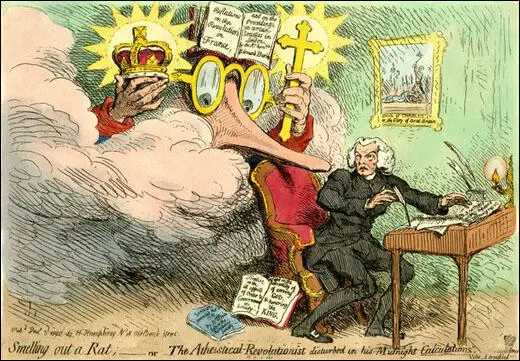
In November, 1789, Richard Price preached a sermon praising the French Revolution. Price argued that British people, like the French, had the right to remove a bad king from the throne. Edmund Burke, was appalled by this sermon and wrote a reply called Reflections on the Revolution in France, where he argued in favour of the inherited rights of the monarchy. James Gillray joined in the debate by producing a print, Smelling out a Rat (1790). It shows Richard Price seated in an armchair at a small writing-desk. Burke is represented by an enormous spectacled nose which rests on the back of Price's chair and by two gigantic hands, one holding a crown, the other a cross, both of which are surrounded by star-shaped haloes. The spectacles support (between the crown and the cross): "Reflections on the Revolution in France, and on the Proceedings in certain Societies in London, by the Rt honble Edmund Burke." Price's pen drops from his hand; the paper before him is headed "On the Benifits of Anarchy Regicide Atheism". The table is lit by a lamp with a naked flame and reflector. Against his chair leans an open book: "Treatise on the ill effects of Order & Government in Society, and on the absurdity of serving God, & honoring the King". On the wall above Price's head is a picture: "Death of Charles Ist or, the Glory of Great Britain". It shows the execution of Charles I.
Question: Describe the ways that show James Gillray disapproved of Richard Price's views on the French Revolution.
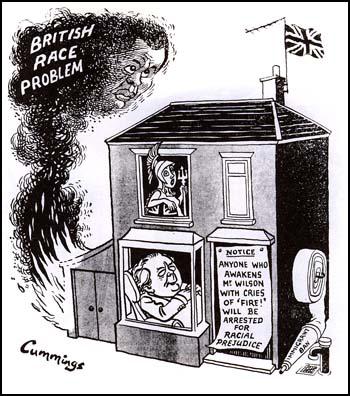
Question: in the summer of 1967 Harold Wilson and his Labour government was in the process of passing a Race Relations Act that would make it illegal to refuse housing, employment, or public services to a person on the grounds of colour, race, ethnic or national origins. What was Michael Cummings view on this legislation?
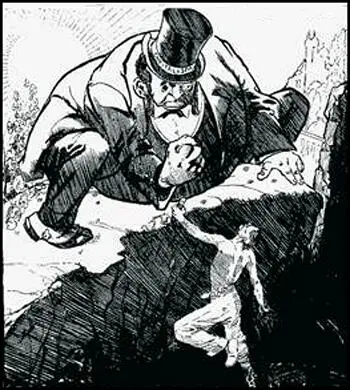
LABOUR WANTS A "PLACE IN THE SUN"!
CAPITAL (deeply shocked at Labour's efforts to emerge): "Back to
your abyss, Sir! As it is already there is scarcely enough sun to go round!"
Question: How does this cartoon explain the political opinions of Will Dyson and the The Daily Herald newspaper?
Question: The Habeas Corpus Act passed by Parliament in 1679 guaranteed that a person detained by the authorities would have to be brought before a court of law so that the legality of the detention may be examined. In times of social unrest, Parliament had the power to suspend Habeas Corpus. William Pitt did this in May 1793 during the war with France. Parliamentary reformers such as Thomas Hardy and John Thelwall were imprisoned as a result of this action.
Habeas Corpus was also suspended in January 1817 after a missile had been thrown through the glass window of the Prince Regent's coach on the way to the opening of Parliament. Supporters of parliamentary reform were blamed for this act of violence and Lord Liverpool and his government rushed through Parliament the Gagging Acts. These measures banned meetings of over fifty people and instructed magistrates to arrest everyone suspected of spreading seditious libel.
The Gagging Acts severely hampered the campaign for parliamentary reform. However, as soon as Parliament decided to restore Habeas Corpus in March, 1818, there was an immediate revival in the demands for universal suffrage.
How does George Cruikshank explain his disagreement with the Gagging Acts?
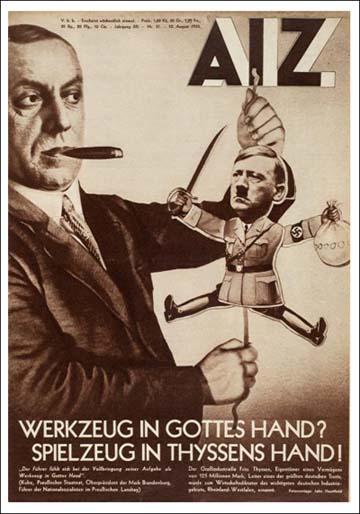
(Copyright The Official John Heartfield Exhibition & Archive)
Question: John Heartfield, a member of the German Communist Party (KPD), worked for the socialist magazine, Arbeiter-Illustrierte-Zeitung (AIG). His photomontages (the production of pictures by rearranging selected details of photographs to form a new and convincing unity) often appeared on the front cover of the magazine. The cover above shows Fritz Thyssen, the owner of United Steelworks, a company that controlled more that 75 per cent of Germany's ore reserves and employed 200,000 people. Explain the meaning of this photomontage.

Question: In 1868 Horatio Seymour was nominated as the Democratic candidate to run against Ulysses S. Grant. In his campaign Seymour advocated a policy of conservative, limited government, and he opposed the Reconstruction policies of the Republicans in Congress. Seymour's campaign was also marked by pronounced appeals to racism with repeated attempts to brand General Grant as the "Black Man's" candidate and Seymour as the "White Man's" candidate.
During the campaign, Thomas Nast, produced several cartoons for Harper's Weekly attacking his campaign. One of these drawings shows Seymour joining hands with the Irish vote and the Confederate vote. Explain the positioning of the four men in the cartoon.
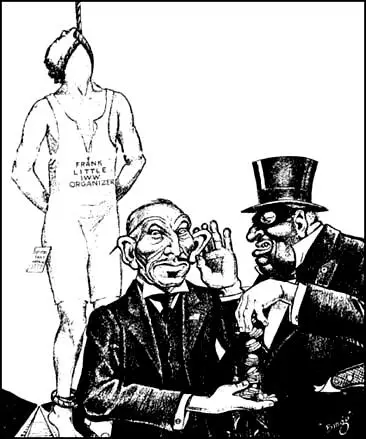
Solidarity Magazine (11th August, 1917)
Question: In the summer of 1917, Frank Little, an official of the trade union of the Industrial Workers of the World, was helping organize workers in the metal mines of Montana. This included leading a strike of miners working for the Anaconda Company. In the early hours of 1st August, 1917, six masked men broke into Little's hotel room in Butte. He was beaten up, tied by the rope to a car, and dragged out of town, where he was lynched. A note: "First and last warning" was pinned to his chest. No serious attempt was made by the police to catch Little's murderers. Little was opposed to United States involvement in the First World War. It is not known if he was killed for his anti-war views or his trade union activities. What message is the cartoonist attempting to communicate.
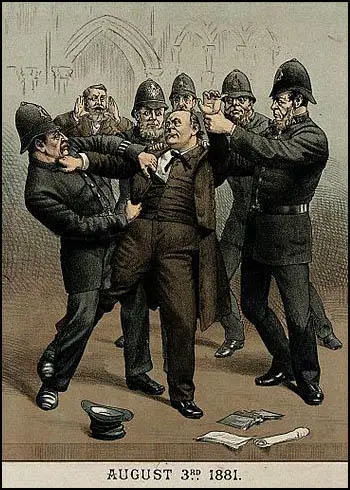
Question: Charles Bradlaugh was a member of the Liberal Party and in the 1880 General Election he won the seat of Northampton. However, when he tried to take his seat in the House of Commons, he was expelled from Parliament. Why?

Question: Ernest Ibbetson providing the art work for the famous First World War poster, Women of Britain Say - Go! (May, 1915) that was commissioned by the Parliamentary Recruiting Committee. One critic wrote: "The poster powerfully captures the division between men and women during this period and cleverly manipulates the viewer into a noble motivation for enlisting." Explain what he means by this comment.
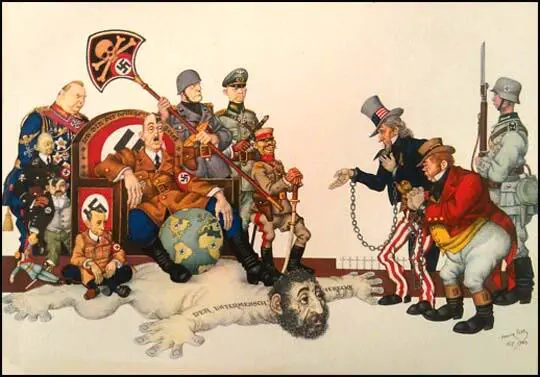
Question: Arthur Szyk was born into a Jewish family in Poland. Szyk became a strong opponent of Adolf Hitler and his regime in Nazi Germany. He was quoted as saying "I am but a Jew praying in art" and "art is not my aim, it is my means." He later said: "An artist, and especially a Jewish artist, cannot be neutral in these times.... Our life is involved in a terrible tragedy, and I am resolved to serve my people with all my art, with all my talent, with all my knowledge."
In December, 1940, Arthur Szyk, his wife and daughter moved to New York City. What is Szyk saying in his cartoon? How does the date help to explain the cartoon.
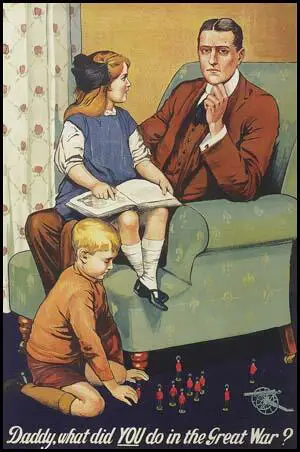
Question: This poster was published during the early stages of the First World War? Explain why it became one of the most successful recruitment posters of the war.
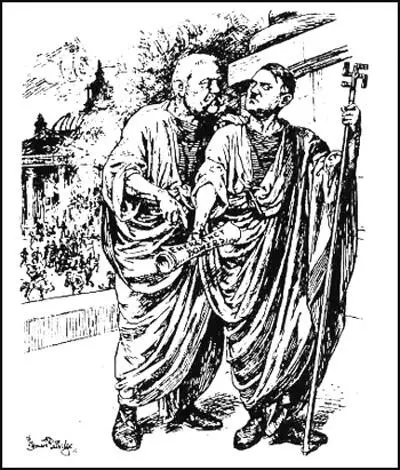
Question: Read the page on the Reichstag Fire and explain what Bernard Partridge meant by "The Red Peril – This is a heaven sent opportunity my lad. If you can't be a dictator now you never will."?

